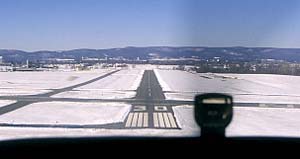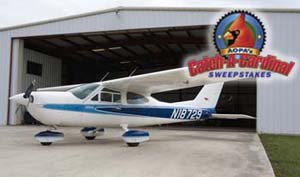| This ePilot Flight Training Edition is sponsored by

Advertisers
            
Do not reply to this e-mail. Got news? Contact ePilot. Having difficulty using this service? Visit the ePilot Frequently Asked Questions now at AOPA Online or write to [email protected].
Aircraft Owners and Pilots Association
421 Aviation Way
Frederick, MD 21701
Tel: 800/USA-AOPA or
301/695-2000
Copyright © 2006 AOPA. | Training Tips
| | SNOW, ICE, AND AIRPORTS
 There's nothing like snow season to change the daily routine at a familiar airport. Whether your planned flight is local or a cross-country, once snow hits the surface, pilots must stay on the alert for so-called contaminated runways, taxiways, and ramps. After a storm, plowing and clean-up operations could continue for a long time. Check notams and monitor ATIS broadcasts for closures and delays coded PPR: prior permission required. Snowdrifts created by plowing may be waiting to snag a wing tip; use care especially when maneuvering in confined areas such as on the ramp or while turning at intersections of runways and taxiways. Residual surface ice and refrozen melted snow is a concern even during stretches of good weather. There's nothing like snow season to change the daily routine at a familiar airport. Whether your planned flight is local or a cross-country, once snow hits the surface, pilots must stay on the alert for so-called contaminated runways, taxiways, and ramps. After a storm, plowing and clean-up operations could continue for a long time. Check notams and monitor ATIS broadcasts for closures and delays coded PPR: prior permission required. Snowdrifts created by plowing may be waiting to snag a wing tip; use care especially when maneuvering in confined areas such as on the ramp or while turning at intersections of runways and taxiways. Residual surface ice and refrozen melted snow is a concern even during stretches of good weather. "Even if the runway is available there may still be, in notam language, PSR (packed snow on the runway), SLR (slush on the runway), or LSR (loose snow on the runway). If you land off the centerline to avoid ice, or when taxiing, watch out for SNBNK (snow banks caused by plowing). There could be snow-removal equipment in proximity. Some of these vehicles are huge; most have flashing lights. Occasionally someone doesn't get the word that it's time to let the aircraft land again, so be ready to make that out-of-the-flare go-around," was some of the advice you'll find in the December 2006 AOPA Pilot feature "Flying Seasons: Winter Wonderland?" It continued, "If braking advisories are in effect, monitor whether runways have BRAG, BRAF, BRAP, or BRAN-notam contractions telling you that braking action is good, fair, poor, or nil." See Chapter 5 of the Aeronautical Information Manual for a full discussion of the notam system and a list of notam contractions. Treacherous conditions have been the cause of numerous mishaps. Learn from what has happened to other pilots as described in the "Accident Analysis" column in the December 2006 AOPA Flight Training. Winter surface conditions can even make runways-or entire airports-hard to find from the air. Just as cold-weather operations require special methods of preparing and flying your aircraft (see the November 10, 2006, Training Tips article "The Cold Facts"), airports require special "handling" in wintertime too. Do it right, and reap the rewards.
| Your Partner in Training
| | Many people want to learn to fly but aren't sure if they can progress through the requirements of the private pilot certificate. If that's your situation, don't forget you have options. You can earn a recreational pilot certificate or a sport pilot certificate. Both require fewer hours of training than a private pilot certificate (which translates to fewer dollars spent), but they also pose limitations on the type of flying you can do and the aircraft you can fly. For more information, see the AOPA's Guide to Learning to Fly on AOPA Online. If you have questions, call AOPA's Pilot Information Center at 800/USA-AOPA weekdays from 8:30 a.m. to 6 p.m. Eastern. As an AOPA Flight Training member, you have access to all of the features within AOPA Online and AOPA Flight Training Online. Login information is available online.
| Flight Training News
| | EMBRY-RIDDLE SUFFERS EXTENSIVE TORNADO DAMAGE
Embry-Riddle Aeronautical University (ERAU) officials are assessing the damage after Christmas Day tornados hit two Florida counties, including the school's fleet of airplanes and campus buildings. As many as 50 airplanes were damaged or destroyed by the tornado in Daytona Beach. Most of the airplanes were Cessnas. Students are due to return to class on January 10, but the university said it is working with local officials to do everything it can to provide classroom space as well as replace the airplane fleet. LOCKHEED MARTIN GRADUATES 46 FLIGHT SERVICE SPECIALISTS
Forty-six new flight service specialists graduated on December 21 from Lockheed Martin's Flight Service Academy in Prescott Valley, Arizona. Each of the graduates has completed 10 weeks of training, including prerequisite core knowledge in such subjects as meteorology and basic navigation. They'll be assigned to one of 58 flight service stations across the country. Lockheed Martin assumed operation of the flight service stations in October 2005 under a $1.7 billion outsourcing contract by the FAA. TEXAS COMMUNITY COLLEGE MULLS AVIATION PROGRAM
Angelina College, a two-year community college in Lufkin, Texas, is in talks with a local company about setting up an aviation program. According to a report in the Lufkin Daily News, the flight school would operate out of Angelina County Airport, and ground school classes would be held at the college. Maximum Aviation of Lufkin has expressed interest in providing training with the hopes of starting a program in fall 2007. FLORIDA TECH REVAMPS PROGRAM TO BOOST ENROLLMENT
Coping with a downturn in enrollment, Florida Institute of Technology's College of Aeronautics has instituted several new courses, including a graduate-level aviation security class that examines global security issues. According to a report in Florida Today, the school's enrollment has dropped from 750 in the 1990s to the current student body of 340. Interim dean Ken Crooks said the changes in the aviation program are in response to the cyclical nature of the aviation business. The College of Aeronautics awaits completion of a new aviation center at Melbourne International Airport, estimated for spring 2008.
| Inside AOPA
| YOU GET THE FIRST PEEK AT OUR NEXT SWEEPS AIRPLANE
 As an ePilot subscriber you're the first to receive the official word: AOPA's 2007 Catch-A-Cardinal Sweepstakes features a Cessna Cardinal 177B, with fixed gear and a 180-horsepower engine. It's a sleek performer that you can fly well, afford to maintain, and use to get around in comfort and style-and we're going to make it sing. The stock 177B cruises at 124 knots, burns about 10 gallons an hour at moderate cruising altitudes (5,000 to 7,000 feet msl), and can take off and land comfortably within 2,000 feet. New this year: We're stripping this Cardinal down to its bare metal and refurbishing the airplane from the inside out. With a factory remanufactured O-360 from Lycoming and new airframe parts from Cessna, this will be one slick bird. On the panel side, we'll be putting in a WAAS-capable Garmin GPS/nav/com avionics stack with a multifunction display, an S-Tec autopilot, an L-3 Communications Stormscope lightning detector, a J.P. Instruments engine monitor, and a backup attitude indicator. In addition, we're making the airplane conversant with ADS-B (automatic dependent surveillance-broadcast) datalink technology so the lucky winner can access free weather and traffic information in expanding coverage areas. Throw in new interior upholstery and plastics, and a bunch of other goodies to fill out your flight bag-and you have quite a prize. To complement our coverage of the project in the pages of AOPA Pilot, we'll be posting online updates featuring photos, video, and other multimedia treats every other week. Join us for the first update on January 1! Just in case you're wondering, we still haven't given away this year's Piper Cherokee Six. ePilot subscribers will be the first to know when we present it to the winner in early 2007. As an ePilot subscriber you're the first to receive the official word: AOPA's 2007 Catch-A-Cardinal Sweepstakes features a Cessna Cardinal 177B, with fixed gear and a 180-horsepower engine. It's a sleek performer that you can fly well, afford to maintain, and use to get around in comfort and style-and we're going to make it sing. The stock 177B cruises at 124 knots, burns about 10 gallons an hour at moderate cruising altitudes (5,000 to 7,000 feet msl), and can take off and land comfortably within 2,000 feet. New this year: We're stripping this Cardinal down to its bare metal and refurbishing the airplane from the inside out. With a factory remanufactured O-360 from Lycoming and new airframe parts from Cessna, this will be one slick bird. On the panel side, we'll be putting in a WAAS-capable Garmin GPS/nav/com avionics stack with a multifunction display, an S-Tec autopilot, an L-3 Communications Stormscope lightning detector, a J.P. Instruments engine monitor, and a backup attitude indicator. In addition, we're making the airplane conversant with ADS-B (automatic dependent surveillance-broadcast) datalink technology so the lucky winner can access free weather and traffic information in expanding coverage areas. Throw in new interior upholstery and plastics, and a bunch of other goodies to fill out your flight bag-and you have quite a prize. To complement our coverage of the project in the pages of AOPA Pilot, we'll be posting online updates featuring photos, video, and other multimedia treats every other week. Join us for the first update on January 1! Just in case you're wondering, we still haven't given away this year's Piper Cherokee Six. ePilot subscribers will be the first to know when we present it to the winner in early 2007. WANT TO LEARN THE NUTS AND BOLTS OF GPS?
The AOPA Air Safety Foundation has a self-paced, 15-minute online course that focuses on the few functions that pilots typically use in VFR flight. VFR GPS Guide: Garmin 430/530 is the first in a series of foundation minicourses on various panel-mount GPS receivers. SAY INTENTIONS: HOW ATC CAN BE YOUR FRIEND
When pilots find themselves headed for trouble, they often forget one of the most useful tools in the cockpit: air traffic control. By offering you a "flight assist," a controller can help you navigate any number of in-air problems. Yet few pilots use this valuable service. The AOPA Air Safety Foundation's Say Intentions... online course explains why you, the pilot, should add the flight assist to your bag of tools. You'll learn through hands-on training when to call for a flight assist, and how to work with controllers to get yourself out of harm's way. HAVE YOU UPDATED YOUR AOPA MEMBER PROFILE?
To make the most of your membership and allow us to serve you better, please visit AOPA Online and update your personal member profile.
| Training Products
| | GLEIM ANNOUNCES NEW VERSION OF ONLINE GROUND SCHOOL
Gleim Publications Inc. has released a new version of its online ground school. The new version features up-to-date information in a new format that offers flexible study options. Existing customers may access either version, but Gleim advises that if you choose to begin the new course, you will not be able to retain your course history from your current course or receive credit for questions already answered or sections previously completed. You begin the course as a new user. If you choose to continue using the current course, you will retain all current programs. The expiration date of either version is two years from original date of purchase. Online ground school programs are available for sport, private, instrument, commercial, CFI, and ATP. Each costs $99.95. For more information, see the Web site. Note: Products listed have not been evaluated by ePilot editors unless otherwise noted. AOPA assumes no responsibility for products or services listed or for claims or actions by manufacturers or vendors.
| | Final Exam | | Question: Does AOPA have resources to help me better understand and prepare to fly with a glass cockpit panel? Answer: Yes. AOPA's subject report, "Glass Cockpit Technology," offers links to numerous AOPA Pilot articles that will give you the insight needed to feel more comfortable flying behind the glass. Glass cockpit aircraft, also referred to as "technically advanced aircraft" (TAA), are not manufactured to a one-size-fits-all standard like the VOR navigation system installed in older aircraft and require specific training from one unit to the next. To help with this, the AOPA Air Safety Foundation publication, Technically Advanced Aircraft Special Report , gives an outline of the challenges of TAA training and an analysis of some TAA accident reports. Finally, you can also contact the glass cockpit manufacturer to obtain a computer-based simulator software program (for a nominal cost) to help practice the skills you'll need in the cockpit. Got a question for our technical services staff? E-mail to [email protected] or call the Pilot Information Center, 800/872-2672. Don't forget the online archive of "Final Exam" questions and answers, searchable by keyword or topic.
| Picture Perfect
| Looking for some really fabulous aviation photography? All the air-to-air photos and beautifully detailed ground images used by AOPA Pilot magazine over the years are yours at the click of a mouse button. Download your favorite images to use for wallpaper, send an e-postcard, or order prints online. For more details, see AOPA Online.
| Weekend Weather
| See the current weather on AOPA Online, provided by Meteorlogix.
| ePilot Calendar
| UPCOMING FLYING DESTINATIONS:
There are no national calendar items this week. To submit an event to the calendar or to search all events visit AOPA Online. For airport details, see AOPA's Airport Directory Online. FLIGHT INSTRUCTOR REFRESHER CLINICS
The next AOPA Air Safety Foundation Flight Instructor Refresher Clinics are also scheduled in Long Beach, CA; Portland, OR; and San Antonio, January 6 and 7. Clinics are also scheduled in San Jose, CA; Detroit; and Rochester, NY, January 13 and 14. For a complete schedule, see AOPA Online. Can't make it in person? Sign up for the CFI Refresher Online. AOPA AIR SAFETY FOUNDATION SAFETY SEMINARS
AOPA Air Safety Foundation Safety Seminars are scheduled in Van Nuys, CA, and Reno, NV, January 8; Sacramento, CA, January 9; Milpitas, CA, January 10; and San Diego, and Santa Rosa, CA, January 11. The topic is "Say it Right! Radio Comm in Today's Airspace." For details and a complete schedule, see AOPA Online.
| |